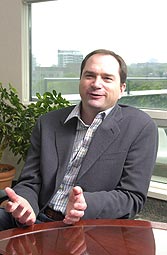Photography by Simon Buckley
Robert Milton's plan to recognise the value in Air Canada by "monetising" the carrier and its subsidiaries may work all too well, putting him and his holding company out of business
For Robert Milton, chairman and chief executive of ACE Aviation Holdings, it has been a long trip from Georgia in the USA's deep south to Montreal in Canada's frostier culture. Similarly, it has been a long journey from watching turboprops at a one-runway airport near New York City to overseeing Air Canada. If Milton has his way, the journey may eventually take him out of the airline business and could well take his company out of owning things outright.
The evolution of ACE from struggling flag carrier into money-making holding company is the story of turning side dishes into main courses. Milton's central achievement, which comes at a time when the concept of basic airline business models is being rewritten, was to take the ancillary businesses - the standbys - and make them at least as important as the core.
 |
|---|
| "We've come to the conclusion we don't need to own any of these companies" |
The strategy has attracted praise for the difficult achievement of monetising assets while retaining control. In fact, the ACE strategy and achievement so far won the praise of a distinguished panel of judges in this magazine's recent Airline Strategy Awards, when ACE Aviation Holdings won the Finance category. The strategy may have been often mulled over in airline boardrooms, but rarely has moved beyond the talking and strategising stages. In some instances, the threat to sell off a major unit of an airline holding company has been just that - a threat, intended to chivvy recalcitrant unions or creditors into line or simply an expression of management frustration.
Strategic challenge
Milton's monetisation strategy has worked perhaps too well, with the spin-offs performing better as investments than the airline itself, leading Milton to lament that "if you buy ACE Holdings, you're essentially getting the airline [component of ACE] for free". But he has taken the dilemma as a logical challenge to be bested by his basic strategic thinking, rather than a psychological barrier to be surmounted by rhetoric: if people do not recognise the value of Air Canada the airline, put it on the market and make them focus. That will "surface value", to use his phrase, and Milton announced in mid-August that ACE will launch a public offering of a minority stake in Air Canada late this year.
The logic does not stop there, however: if selling off chunks of each unit is a good thing, then perhaps selling off more, or indeed all, of everything is a better idea. Or, as Milton puts it: "We've come to the conclusion that we don't need to own any of these companies." In a larger sense: "We've definitely gotten our heads past the possibility that, sometime, there is no ACE." After all, if investors own all of ACE Aviation's holdings, then ACE Holdings has no raison d'etre unless it moves on and buys something else. Milton will not rule out either future, but says: "Perhaps ACE will just be a series of companies one after the other."
 |
|---|
The strategy has its genesis in Air Canada's well-known struggle for control of its destiny in the face of an unsought takeover bid, its own takeover of its largest domestic competitor, and then the fight to reshape its destiny through a 19-month-long stay in the Canadian version of bankruptcy reorganisation. It was during this process that Milton and his management team began their consideration of the monetisation strategy, which he sometimes calls "the platform strategy" - making ACE Aviation Holdings the platform on which the rest is based.
Other companies have discussed or fantasised about selling off their frequent-flyer plans, but what Milton did was more than just sell something. He floated a chunk of Aeroplan while moving to transform the 6 million-member frequent-flyer programme into a larger nationwide, multi-retailer loyalty plan. This would bring in revenue from third parties and would stand at enough of a distance from Air Canada that both the airline and the loyalty plan could focus on the value of its unique currency - points.
The flotation of Aeroplan in June 2005, in which ACE maintains 75.3% ownership, drew six times more investors than shares available, and brought in a price ($200 million) that was almost four times higher than the one discussed two years earlier when the deal was first seriously considered. Milton says that the structure "adds a lot of discipline to our dealings with Aeroplan and so to our entire way of thinking about marketing. We really know what miles cost, unlike most airline guys who just say, 'Hey let's give people triple miles' or whatever in an attempt to bring in revenue without really knowing what the effort costs them. If you know what you are paying, you have a much more focused idea of the value."

Because Aeroplan is a freestanding company, it must pay Air Canada for reward seats, thus removing the possibility of giving away freebies because they might actually bump a paying passenger. At Aeroplan, the diversification has boosted volume, and led to a 230% year-over-year increase in non-air reward redemptions in 2005 over 2004, lowering the redemption cost to just under 8¢ a mile, almost 3% down in a year.
|
|
|---|
|
Robert Milton, 47, grew up in the USA, UK, Singapore, Belgium and Hong Kong as his father, an international banker, moved around the world. He remembers when he first "got hooked"- on a flight from the New York City area to St Louis in an executive jet. "They let me up in the flightdeck, and that did it," he says. Milton graduated in 1983 from Atlanta's Georgia Tech with a degree in industrial management and a gift from his father to buy a new car. He used the money instead to start an air courier dubbed Midnight Express, which he sold to Piedmont Aviation. In 1993 he become a full-time Air Canada employee, rising through the ranks until in 2000 he led the purchase of rival Canadian Airlines International, while fending off a hostile takeover attempt. In 2003 he put Air Canada in reorganisation under CCAA, the Canadian version of Chapter 11 bankruptcy protection. A year later he brought Air Canada out in the form of ACE Aviation Holdings. He sold stakes in Aeroplan and Jazz and in August announced plans to sell a stake in Air Canada itself. The sale of its services unit is also on the cards. Milton is married with two children. |
Maintenance business up for sale
It is only at the maintenance unit, Air Canada Technical Services (ACTS), that the strategy has not achieved strong results, and Milton says getting ACTS ready for a sale is the priority for 2006. The unit won some work from US Airways in a deal linked with an ACE investment in that carrier. But at the same time it was aggressively seeking outsourced work, probably taking on more than it should have, including a major Delta contract. Milton says: "We've got to find a way to make the relationship work for Delta and for ACTS."
But he praises the new management at ACTS, including its president and chief executive, Charam Bolouri, hired from telecoms powerhouse Nortel Networks in January 2006. Bolouri brought in a new team to assist in the turnaround. By mid-August, the turnaround was working well enough that Milton was able to announce a planned monetisation for ACTS, more likely in the form of a sale than a partial spin-off. John Luth from investment bank Seabury Group says that "eventually, ACTS could become an amalgamator or aggregator of other MROs", just as Aeroplan could become an amalgamator of other loyalty plans or a major backroom provider to them in a business area that is highly fragmented. Luth, who was a key adviser to Milton in the creation of ACE, notes that no citizenship rules or investment limits apply to the maintenance or loyalty units, which make them all the more attractive to global investors.
Milton's conversation gravitates as much towards ACE, the holding company, as the airline itself, in large part because of the deep confidence he has in former United Airlines executive Montie Brewer, who has been running the airline for four years. They have a very detailed plan for the airline - as many as 96 new long-distance aircraft, Boeing 777s and 787s - to develop an even more focused international route network with deep reach into the Pacific Rim and south Asia and traditional European markets. This is in addition to 34 larger Embraer 100-seaters to link up the airline's regional hubs as well as five service-specific fare levels that encourage customers to pay more for what's clearly offered and specifically detailed, rather than included by implication or tradition. The pricing philosophy has worked, with domestic yields rising and Tango-Plus fares, one of the most difficult selling propositions aimed at the truly bargain conscious, rising 65% year-on-year.
Low-cost mistakes
The names "Tango" and "Tango-Plus" reflect one of the few mistakes that Milton and Brewer have made. Tango was a separate long-haul, low-fares unit with a dedicated fleet that lasted three years from April 2001, along with Zip, another discrete airline effort to fend off low-fares competition in the west that lasted between September 2002 and 2004. Now, though, rather than fly separate fleets, the airline offers the fare and service counterparts to the Tango and Zip fleets on board each aircraft, differentiating them not physically but by price.
It has worked better than the now-repainted neon and purple fleets of Tango and Zip ever did, since Air Canada and Jazz have a 60% domestic market share, having held off inroads by 10-year-old WestJet Airlines to a 32% market share, while enlarging the $4.5 billion domestic national market. Milton has hopes that pre-purchased fares, sold in the form of multi-trip passes, will keep strong cash flows constant. The airline just rolled out these prepaid passes to the US market and is, Milton recalls, enjoying strong response to such products as a pass tailored for Newfoundlanders who commute on a weekly or monthly basis to their oilfield jobs in western Canada.
Milton was so focused on the details of the Air Canada rebranding that in October 2004 he personally took control of such minutiae as the airline's new paint schemes, its modernised graphic-dot "frosted leaf" that modernises its traditional maple leaf logo, even insisting on the little sparkles of light that are mixed in with the unique sky-ocean blue of the fuselage. Colleagues recall that when branding consultants offered various colour schemes or design elements, Milton drew upon his vast knowledge of airline history and refused to accept any that was reminiscent of other carriers - anywhere. The usually reserved and restrained Milton all but lights up when talking about Air Canada's new aircraft and what they can do. He can tell by registration letters which of the airline's 201 mainline aircraft are in for heavy-maintenance checks or which are assigned to which routes. If anything, Milton concedes, some airline executives might consider this too hands-on, but this is a man who loves aircraft, who loves flying and who loves the business.
What he does not love are the restrictions that most other airlines chafe under, restraints on where to fly, limits on who can invest in it and a dependence on what Milton calls "natural and abusive monopolies such as airports". It was his interest in fighting these barriers that led him to accept a somewhat surprising invitation from IATA director general Giovanni Bisignani to chair the association's board of governors for 2005-6. That term expired in May, but Milton will not end his often sharply worded advocacy for the issues he believes the industry needs to address. He says: "We have to work together to get traction on these issues. We may not be able to reverse some of the mistakes that we now have to deal with but maybe we can keep something stupid from getting started."
But this does not mean that Milton, just 47 in August, will spend the future where he is. Just as ACE could eventually become "just a series of other companies", so Milton could move on in a year or two. He says: "I suspect that managing a larger airline would be even more draining and challenging. This is the thirteenth largest carrier in the world, and it was difficult enough. There is so much venture capital awash out there, and there are plenty of opportunities." ■
Click here for more Airline Business interviews
Click here for Milton's 2000 interview
Source: Airline Business
























